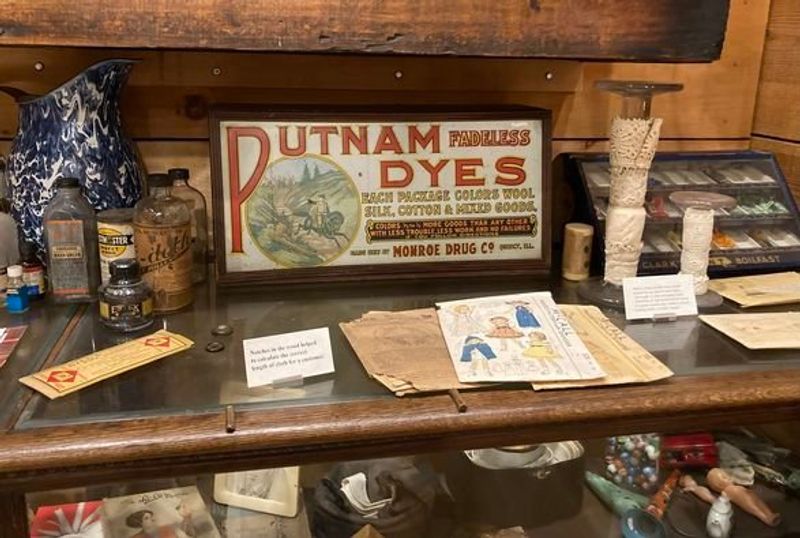PUTNAM FADELESS DYES
Last Updated 12/29/2023
By ESTHER NUNLEY

Original Publish Date: December 27, 2022
At the turn of the 20th century when money was scarce, people would use dyes to add color to their material giving them a colorful choice in clothing or home décor.
The dyes would be available at the local general store set up similar to our permanent general store exhibit at the McMinn County Living Heritage Museum where we have sitting on the counter a Putnam Fadeless Dye case containing some dye packets.
These dyes were a product of the Monroe Chemical Company in Quincy, Mo., a community in Putnam County for which the dye products are named. The company started out in Unionville, Mo., as the Monroe Drug Company founded by Edward Nelson Monroe (b. 1855, d. 1951) in 1876, later becoming the Monroe Chemical Company. Besides compounding his own drugs, he also sold wallpaper, paint, coal oil, gasoline, and his own Black Diamond Headache Cure.
In 1890, Monroe hired James Hugh Elson (b. 1867, d. 1914) who worked as a pharmacist. He was developing a synthetic dye that could be used on a variety of materials namely silk, wool, cotton, linen, rayon, and other mixed goods. Elson combined different types of synthetic dyes to produce his own dye which went on the market in 1893. Response was so great that the company stopped selling drugs in 1895 to concentrate on the marketing of their dyes.
The company advertised in many ways using the news media and their own methods. They created hand-held fans to show customers the wide range of colors they offered, produced wall calendars, color charts, paper bags, and sample packets. The company grew with its slogan “Dyeing Saves Buying.” Monroe eventually moved the company from Unionville to Quincy where transportation services were closer. In 1923 he built a five-story facility and changed the company name to the Monroe Chemical Company.
The Museum’s wooden display case is a circa 1920s. Pictured on the lid is Revolutionary War General, Israel Putnam, for whom the county was named, fleeing on his horse from British soldiers. There is descriptive writing advertising Putnam Fadeless Dyes in bright red type along with a descriptive in yellow that each package colors wool, silk, cotton and mixed goods. Further print in orange states that the colors can do, “1/3 to ½ more goods than any other with less trouble, less work and no failures.” In yellow beneath all the above is “If You Follow Directions.”
Inside the case there are four rows of pigeonholes designed to hold some 36 packets of different colors. In our case we have two color packets, Orange and Nile Green. Each packet sold for 15 cents and can dye or tint up to three pounds of material. Instructions come with each packet which also explains that boiling water is used for dyeing while warm water is used to tint.
Part of the dyeing process also included the company’s “No Kolor Bleach” which removed any color before redyeing an article with the color of your choice. A booklet (not a part of our exhibit) “The Charm of Color” published in 1928 by the company contains 34 pages of information about different materials, what color you should wear, how to beautify the home, the use of their “No Kolor Bleach,” and different designs for “Tied Dyeing.” It ends with a chart that tells you how the color you chose will react with other colors if you chose not to use the bleach first.
They also marketed a “Mary T. Golan Grey Hair Color Restorer,” that only required you to comb it through your hair to restore the natural color. Other Putnam products included a bath additive that would allow you to “bathe your way to beauty” with a single tablespoon of “Bath-Bloom” in the bath water.
The company was first sold in 1951. It changed hands many times after that but changing times and stiffer competition caused the company to close through bankruptcy proceedings in 1976.

